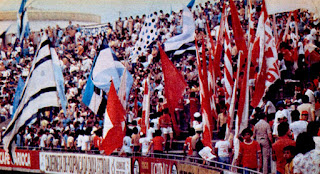Adding Spice to the Showdown: visitors' stands [Off-Season]
My hometown of Porto Alegre is a two-club city just like Adelaide. I got the meaning
of the Showdown really fast. I already knew the basic recipe; I only needed to grasp
the local seasoning. I have learned from my experience in watching derbies in
the stadium that a substantial presence of visiting barrackers causes a
tremendous effect in the game’s atmosphere. The Showdown should have that.
---
I am from Porto Alegre, and we have a football derby: the Grê-Nal. Whenever my beloved Grêmio plays against its archnemesis, Internacional,[1] the entire state of South Rio Grande stops.[2] I imagine you all are well acquainted with such a story. Even though the Grê-Nal is played under Association football rules, it is grounded on a similar spirit as the Showdown.
In Porto Alegre, the derby has currently lost a bit of its charm. The visitor team in Grê-Nal derbies would get 25% of the tickets. So, in a home game, one would see one fourth of the stadium filled up by the opposing supporters. That is not true anymore.
Still, differently than in cities like Buenos Aires, São Paulo, and Belo Horizonte, Porto Alegre has preserved the ingredient that makes derbies so special. The visitors are there, despite being cut down to 5%. At least, recently, a mixed area has been added. The charm of the Grê-Nal has diminished, but it still is the greatest rivalry in Brazilian soccer.
---
I am from Porto Alegre, and we have a football derby: the Grê-Nal. Whenever my beloved Grêmio plays against its archnemesis, Internacional,[1] the entire state of South Rio Grande stops.[2] I imagine you all are well acquainted with such a story. Even though the Grê-Nal is played under Association football rules, it is grounded on a similar spirit as the Showdown.
In Porto Alegre, the derby has currently lost a bit of its charm. The visitor team in Grê-Nal derbies would get 25% of the tickets. So, in a home game, one would see one fourth of the stadium filled up by the opposing supporters. That is not true anymore.
Still, differently than in cities like Buenos Aires, São Paulo, and Belo Horizonte, Porto Alegre has preserved the ingredient that makes derbies so special. The visitors are there, despite being cut down to 5%. At least, recently, a mixed area has been added. The charm of the Grê-Nal has diminished, but it still is the greatest rivalry in Brazilian soccer.
The atmosphere at the derby games used
to be absolutely surreal when I was a kid. Before the match, there was a kind of dialogue
between the supporters, intercalating songs and war cries. The home supporters
had the numerical advantage, but the visitors would compensate that by being concentrated
in a smaller space. During the games, the stands and the field would mingle. The
drama would unveil in front of fans and players - all being alike, simultaneously
spectators and actors; one pushing the other and vice-versa.
If there were sections designated primarily for visitors in Showdowns[3], I believe that the greatest rivalry in Australian football would be even better than it already is. I have watched live both derbies from last year, and the games were great![4] Still, the opposing barrackers add an extra spice to the gameday experience – a spice that, for me, is indispensable.
Looking at the common stadium’s seating chart, the best place for giving the visitors priority on tickets would be “The Hill” and sections 141-146. Those are general admission for Port games, anyway. West Lakes would need to adjust most part of its Category 7 membership. However, an easy solution would be having tickets to the away Showdown, instead of the home one.
If there were sections designated primarily for visitors in Showdowns[3], I believe that the greatest rivalry in Australian football would be even better than it already is. I have watched live both derbies from last year, and the games were great![4] Still, the opposing barrackers add an extra spice to the gameday experience – a spice that, for me, is indispensable.
Looking at the common stadium’s seating chart, the best place for giving the visitors priority on tickets would be “The Hill” and sections 141-146. Those are general admission for Port games, anyway. West Lakes would need to adjust most part of its Category 7 membership. However, an easy solution would be having tickets to the away Showdown, instead of the home one.
I still remember the exactly moment when
I fell in love with the Grê-Nal, even if almost twenty years later. It has
nothing to do with Motlop’s goal; but almost the opposite, actually. It was a
Grêmio home game, and Internacional had just scored. Instead of the deafening
silence I was used to listen after a visitor’s goal, I was struck by the loud roar
coming from the opposite stands. It was as awful as powerful as beautiful.
I had never felt anything like that
before. The unity between stands and field had been broken, and I was feeling powerless
and miserable. Meanwhile, they were singing as if happiness knew no end. The
game restarted, and, suddenly, all that I wanted was to scream my lungs off and
out-noise them at all costs. As the team struggled to recover from the goal, Grêmio
fans rose to their feet and rejoined the game. I wasn’t that powerless anymore.
I was playing again.
That experience has never left me ever since. My first Grê-Nal away only added to it. Derbies are a journey. The outcomes are merely stops along the way. I have lived victories and defeats, and they are all part of the fun. I fell in love with the derby after a goal against. It is the whole experience that matters. Such an experience would not be the same if not for the opposite barrackers. The Showdown should have it too.
That experience has never left me ever since. My first Grê-Nal away only added to it. Derbies are a journey. The outcomes are merely stops along the way. I have lived victories and defeats, and they are all part of the fun. I fell in love with the derby after a goal against. It is the whole experience that matters. Such an experience would not be the same if not for the opposite barrackers. The Showdown should have it too.
[Merry Christmas and a Happy 2019 to all of you who enjoy reading Far-West Footy! We will be back after the holidays.]
CARN THE PORT!
---
Notes:
[1] Grê-Nal is formed by the first syllable from
Grêmio and the last syllable from Internacional. It would be like naming the
Showdown as “Cro-Wer.” Picking syllables from teams for derby names is quite
common in Brazil. Usually, the result is meaningless, but not always. Santos and
São Paulo, for instance, play the San-São. “Sansão” is “Samson” in Portuguese.
What a mighty derby!
[2] Since the first derby in 1909, the Grê-Nal has
been played 417 times. We count every game, even the so-called “friendlies” (sic).
[3] There is no need to be exclusive. Tickets would
simply be primarily sold to opposing members for a time, before becoming
available for general admission. It would work like the rest of the stadium,
but with an inverted host.
[4] Although, I haven’t watched them in loco. One day, one day… However, I have
written my impressions on then: Showdown
44; and Showdown
45.





Comments
Post a Comment